Polish Banknotes 1994 – Specimen Series and Unrecorded Types
When Poland introduced its modern złoty on March 25, 1994, the headlines focused on stability and a fresh national design. Yet behind that launch was a quieter story — one involving specimens, test printings, and approval notes that were never meant to circulate. Some slipped into collections, others remained in printer archives, and a few have only surfaced in recent years.
The examples presented here extend beyond what appears in Czesław Miłczak’s catalog, the Standard Catalog of World Paper Money (Pick), or even PMG population data. These notes were always out there — hiding in plain sight — but went unrecognized until now.
This site brings that hidden layer of the 1994 issue into full view. Notes once dismissed as rumors or “white crows” — a Polish expression for something almost impossibly rare — are documented here with clear evidence and high-resolution study images. Some trace directly to confirmed PWPW and Thomas De La Rue production work, while others appear to be one-off anomalies that never reached official records. Together they reveal how Poland’s first modern currency was conceived, tested, and refined. Explore the research here.
A New Era for Poland’s Currency
In 1995, following redenomination, the National Bank of Poland released a new series dated March 25, 1994 — the first issue of the modern złoty (PLN) replacing the old PLZ. Designed by Andrzej Heidrich, the series unified artistry, history, and security into one visual identity. The result was a family of notes that symbolized national renewal and set new standards for Polish banknote design.
Denominations and Designs
- 10 PLN – Mieszko I
- 20 PLN – Bolesław I the Brave
- 50 PLN – Casimir III the Great
- 100 PLN – Władysław II Jagiełło
- 200 PLN – Sigismund I the Old
- (500 PLN – John III Sobieski, added later, outside the 1994 issue)
Each note features a portrait of a Polish ruler on the front, paired with architecture, heraldry, or symbolic scenes from their reign on the back.
Security Features of the 1994 Issue
- Watermark – a second portrait image embedded in the paper, visible when held to light.
- Security thread – a vertical metallic stripe woven through the paper for easy authentication.
- Microprint and raised intaglio printing that provide texture and fine detail.
- Complex guilloché patterns that prevent easy reproduction and define the background texture.
- UV elements – fluorescent fibers and inks visible under ultraviolet light.
What is a Specimen?
A Specimen (pattern or reference note) is a banknote printed for display, training, or testing purposes – never intended for circulation. Specimens can usually be identified by:
- a serial number of “0000000” with prefix AA, or more rarely prefixes such as AX, BB, or others (discussed later),
- for PWPW issues – the typical red overprint “WZÓR” on the obverse and “SPECIMEN” on the reverse,
-
for TDLR (London) issues – a set of distinctive features, including:
- red overprint “SPECIMEN” on both obverse and reverse,
- red oval stamp “SPECIMEN OF NO VALUE / DE LA RUE”,
- two round punch holes piercing the center of the note.
- an additional identifier – a specimen number – applied by the printer, usually in the lower left corner. On PWPW issues this appears as WZÓR Nr, and on TDLR issues as SPECIMEN Nº. These numbers were used to control and track distribution of specimens.
- print quality and security features identical to regular circulation notes.
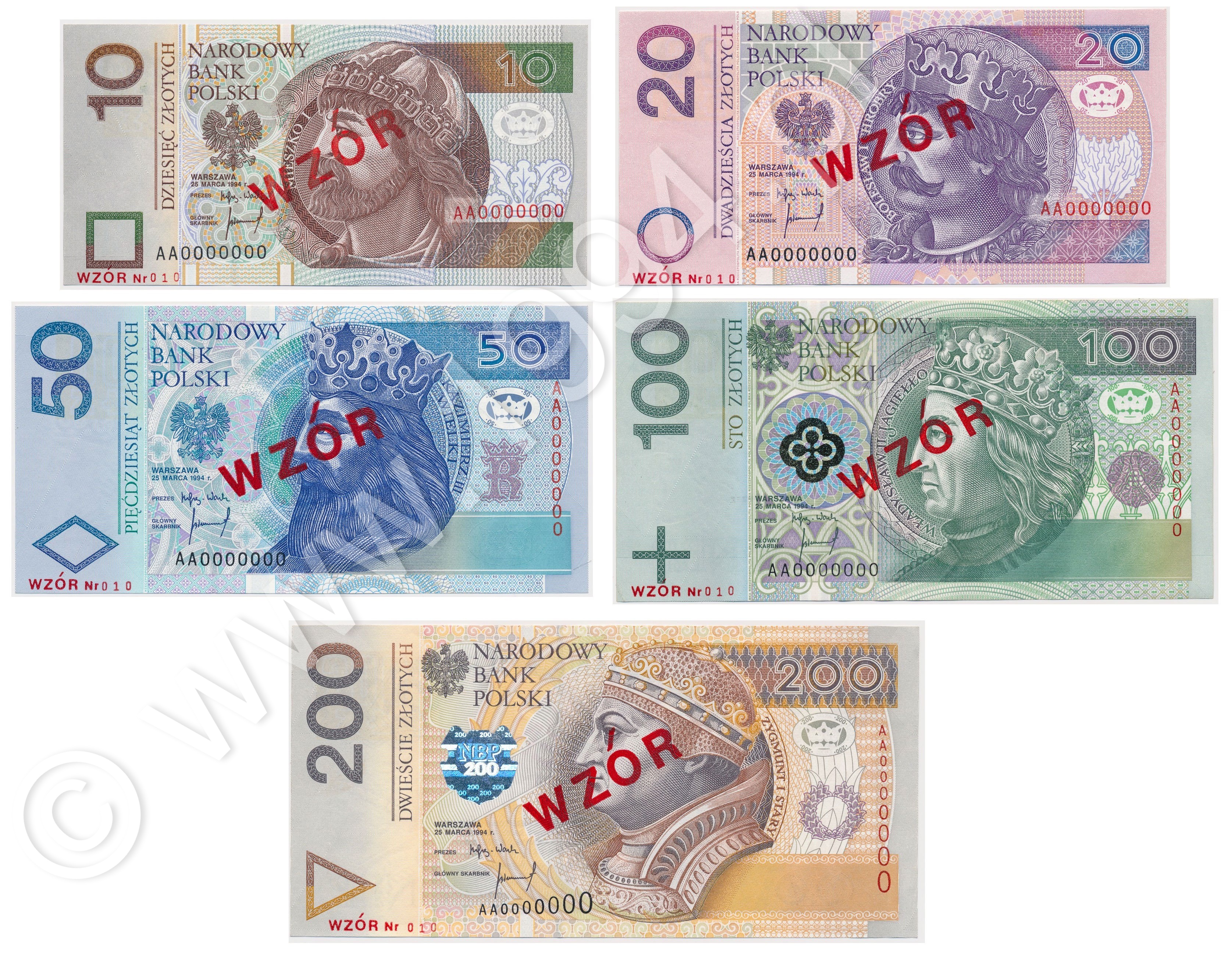
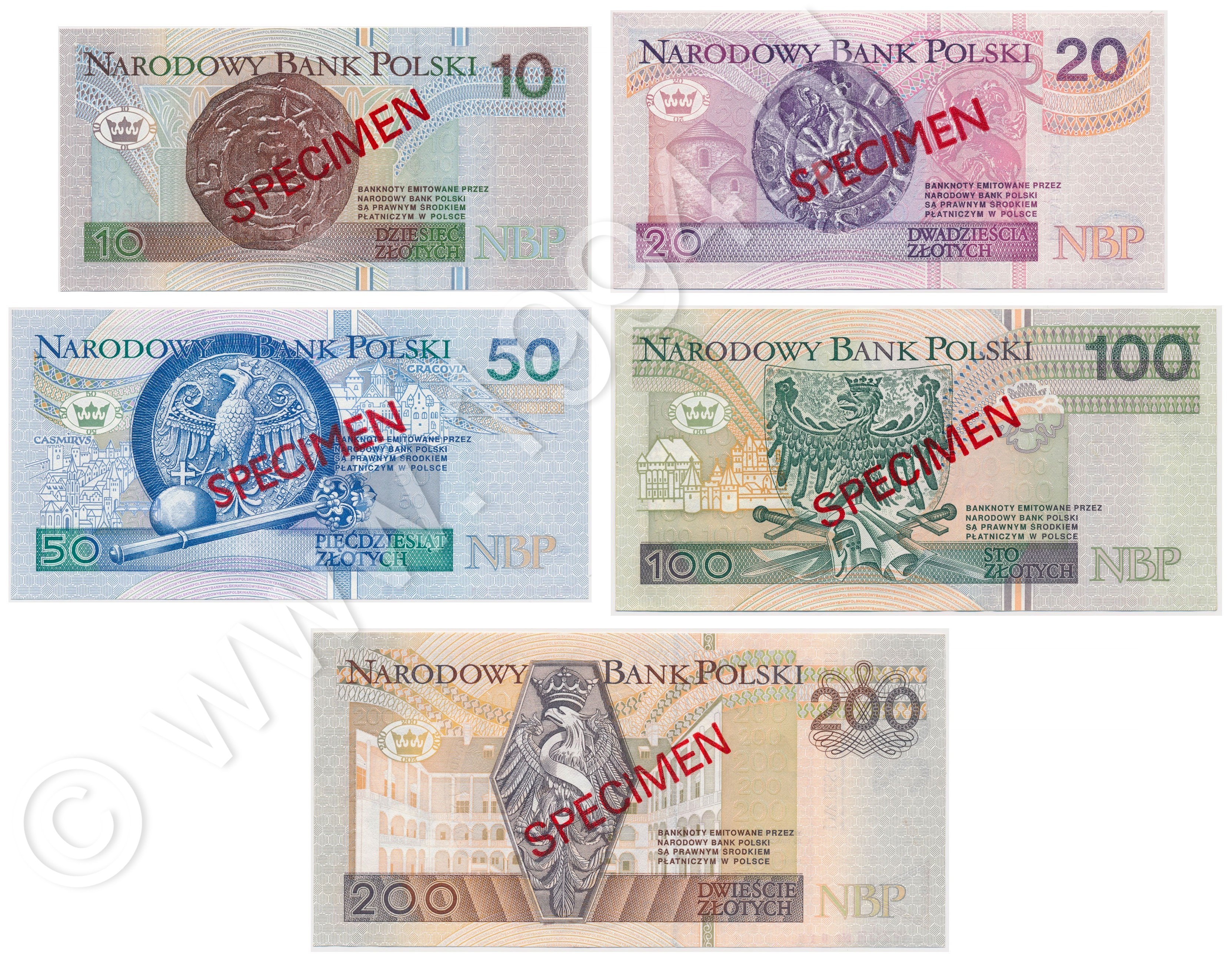
Specimens from the 1994 issue are rare; they were distributed mainly to central banks, museums, and select institutions. On the collectors’ market they are highly sought after, especially in uncirculated (UNC) condition.
Behind the print run: The 1994 notes were designed in Poland, but the first sheets rolled off the presses in London. De La Rue underbid the Warsaw mint by more than 30%, and the National Bank quickly accepted. Time was short — redenomination was only approved in July 1994, but the new złoty had to enter circulation the following year. PWPW couldn’t meet the deadline alone, so Thomas De La Rue took on the job. They printed the entire A–B prefix runs and even part of the C series for the 50-złoty note. Back in Warsaw, production always restarted with DA, which is why the elusive “C” series is absent in most denominations — and in the case of the 50s, the run was cut off midstream.
Frequently Asked Questions
Why are 1994 specimens sought after?
They were printed in very small numbers for institutional use and most survived in pristine UNC condition. They capture the moment of Poland’s 1994 currency reform, making them both scarce and historically significant.
Are 1994 notes still legal tender?
Yes, they remain legal tender in Poland. For collectors, however, the focus is on UNC pieces and specimens, which hold far greater significance than circulated examples.
Is a specimen without overprint considered a variety?
Yes. Catalogues often group them broadly, but in grading and serious collections they are clearly distinguished as “Specimen – without overprint.” This distinction is recognized and adds weight to a collection.
How does grading affect these notes?
Grading certifies authenticity and condition, increases buyer confidence, and often brings a premium at auction. A top-pop slab can dramatically influence market perception.
What is the best way to store them?
Use archival holders or slabs, keep them in stable humidity and temperature, avoid UV light, and protect them from mechanical stress. Proper storage preserves grade and long-term value.
In short: scarcity, condition, and context are what drive lasting demand.
Prefix Distribution and Replacement Series
The table below shows the prefix distribution for all denominations of the 1994 series, divided between TDLR (London) and PWPW (Warsaw). In every denomination, Polish printing always started from the letter D , regardless of where London had finished.
| Denomination | TDLR Prefixes (London) | PWPW Prefixes (Warsaw) | Notes |
|---|---|---|---|
| 10 zł | AA – BZ | DA – KI | C series skipped |
| 20 zł | AA – BF | DA – GY | C series skipped |
| 50 zł | AA – CJ | DA – HI | the only denomination with a partial C series (London); not continued in Poland |
| 100 zł | AA – BQ | DA – JR | C series skipped |
| 200 zł | AA – AR | DA – DY | print run exceptionally short; several replacement series (*star notes*) |
In every denomination, PWPW started from prefix D ; the C series does not appear (exception: 50 zł – partial only at TDLR).
Replacement Series
Replacement series (so-called replacement notes ) were special print runs made to replace defective or damaged sheets of banknotes. Instead of repeating the same serial number, the printer marked them with separate prefixes. For the 1994 series the printer TDLR always used prefix ZA , while in PWPW new ones appeared – YA, YB, YC and so on.
Thanks to this it is easy to identify which examples belonged to “control” reprints. In practice replacement series are much rarer and valued by collectors, since their print runs were many times smaller than regular issues.
The table below presents a breakdown of replacement series for all denominations of the 1994 series – separately for TDLR and PWPW printing.
| Denomination | TDLR (London) | PWPW (Warsaw) |
|---|---|---|
| 10 zł | ZA | YB, YC, YD, YE, YF, YG |
| 20 zł | ZA | YB, YC, YD, YE, YF |
| 50 zł | ZA | YA, YB, YC, YD |
| 100 zł | ZA | YA, YB, YC, YD, YE, YF, YG, YH, YI, YJ, YK, YL, YM, YN |
| 200 zł | ZA | YA, YB, YC |
In short: TDLR used a single replacement series ZA for all denominations; PWPW introduced its own series ( YA, YB, YC… ), which further confirms a different logic of print control.
Printing in London (TDLR) and in Poland (PWPW)
The banknote series dated March 25, 1994 was printed both in London, at Thomas De La Rue & Company, Limited (TDLR), and in Poland, at the Polish Security Printing Works (PWPW) . Below is a simple comparison of the differences collectors focus on.
| Feature | TDLR – London | PWPW – Poland |
|---|---|---|
| Printing location | Thomas De La Rue, London | Polish Security Printing Works |
| Print character | Sharper contours, more intense guilloche colors | Slightly softer colors, finer guilloche lines |
| Specimen markings |
Red overprint:
“SPECIMEN”
on obverse and reverse.
Red oval stamp with text:
SPECIMEN (top), DE LA RUE & CO LTD (center, in rectangle), NO VALUE (bottom). Additionally two round punch holes – only in part of the issue. |
Red overprints: “WZÓR” on the obverse, and “SPECIMEN” on the reverse |
| Paper | Slightly smoother tone and texture | Slightly rougher surface |
| Availability | Extremely rare; only a handful of pieces have appeared on the collectors’ market in the last three decades | Also rare; PWPW WZÓR / SPECIMEN examples show up sporadically, mostly in lower denominations, while higher denominations are practically unobtainable |
Example of All Known 10 zł Variants (1994 Issue)
| Series | Type / Variation | Pick# | CM# | Prefix Range | Printer |
|---|---|---|---|---|---|
| 1st Series (TDLR) | Issued | 173a | 196a | AA–BZ | TDLR |
| 1st Series (TDLR) | Replacement | 173a* | 196c | ZA | TDLR |
| 2nd Series (PWPW SA) | Issued | 173a | 196b | DA–KI | PWPW SA |
| 2nd Series (PWPW SA) | Replacement | 173a* | 196d | YB, YC, YD, YE, YF, YG | PWPW SA |
| Specimens (Prefix AA) | WZÓR (overprint) | 173s | 196Wa | AA | TDLR |
| Specimens (Prefix AA) | Specimen w/ overprint & oval stamp | 173as | 196Wb | AA | TDLR |
| Specimens (Prefix AA) | Approval specimen w/out overprint | Unlisted | 196Wc | AA | TDLR |
| Specimens (Prefix AA) | Specimen perforated | Unlisted | Unlisted | AA | TDLR |
| Specimens (Other prefixes) | Specimen w/ overprint & oval stamp | 173as | Unlisted | BB, BK, BQ... | TDLR |
| Specimens (Other prefixes) | Approval specimen w/out overprint | Unlisted | Unlisted | BB, BK, BQ... | TDLR |
| Specimens (Other prefixes) | Specimen perforated | Unlisted | Unlisted | BB, BK, BQ... | TDLR |
Documented & Unrecorded Types — Polish Banknotes, 1994 Issue
A type describes any note that differs meaningfully from the regular issue — through its serial prefix, printer, added markings such as overprints or perforations, or other production features. These distinctions reveal how each note was made and often set apart the rarest, most collectible pieces from standard circulation issues.
The examples below feature the 20-złoty note in its AA and BB serial prefixes — the first long recognized, the second only recently documented — presented here as representative examples of the broader set of known print types from the 1994 issue.
To explore every variety identified so far, view the complete illustrated 20-złoty sequence (eight documented types) .

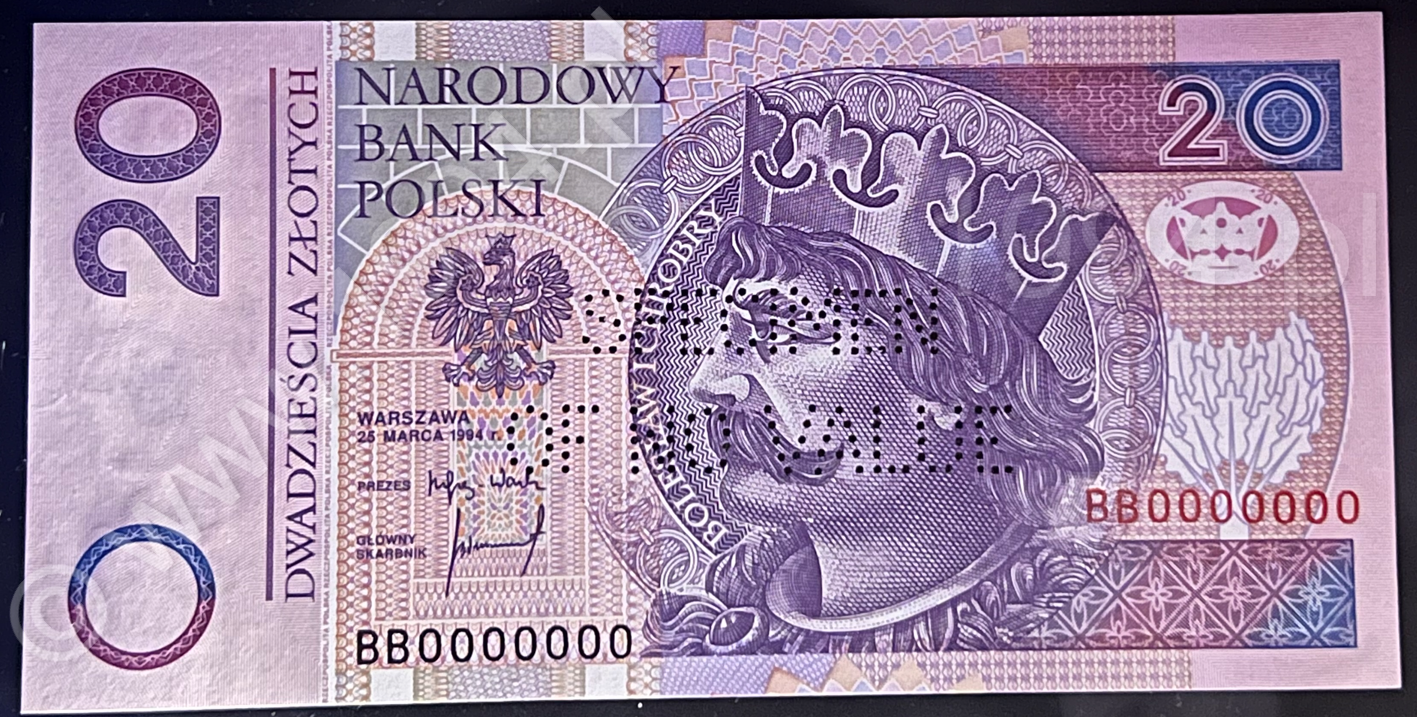


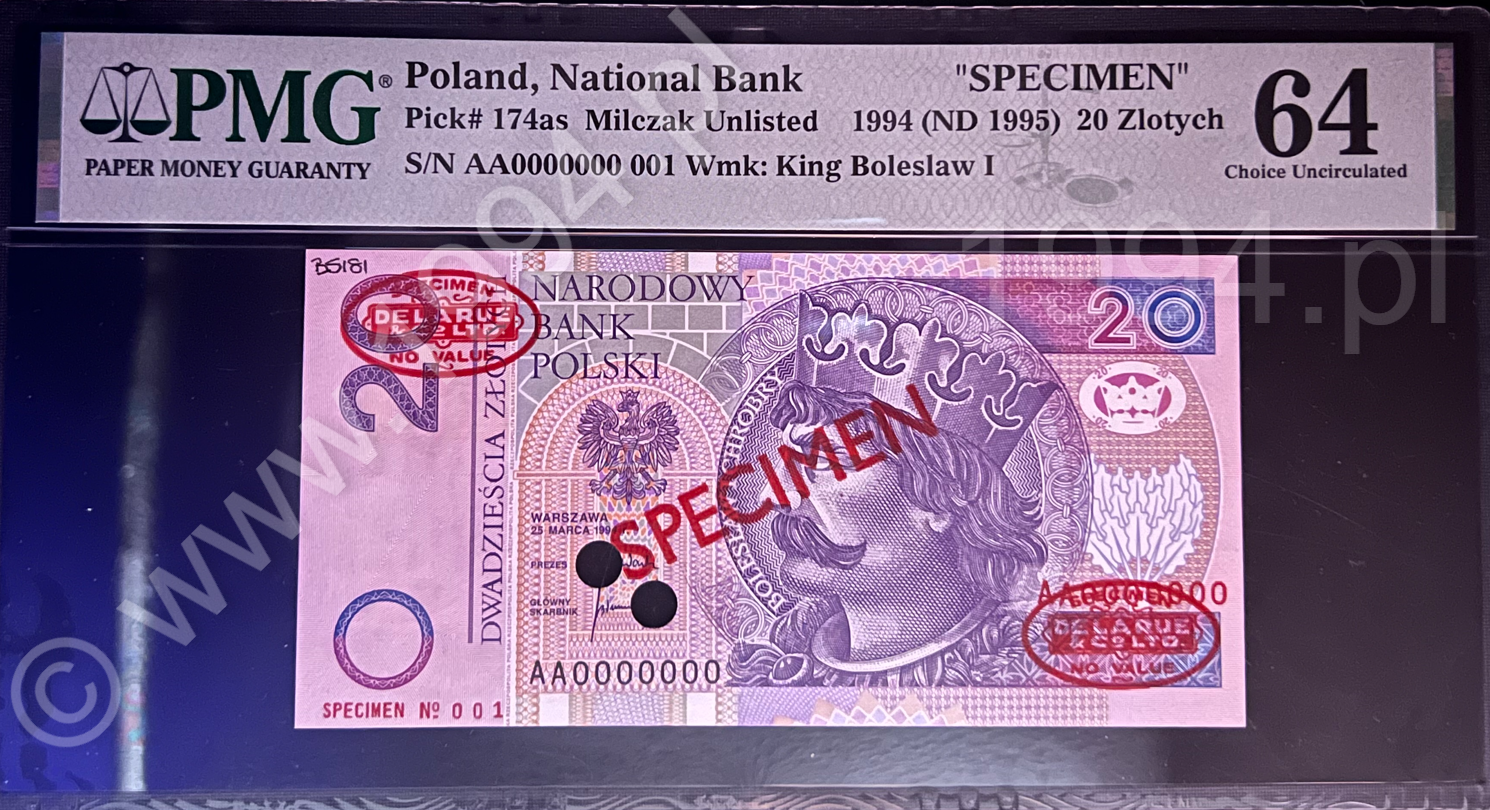
Type System of the 1994 Issue — Illustrated with the 20-Złoty Note
In Miłczak’s catalog, the letters a, b, c, d identify circulation and replacement issues, while Wa, Wb, Wc denote specimen types. The perforated specimen presented here, Wd, does not appear in Miłczak’s listings — the designation is introduced by the author to continue the established sequence logically (Wa–Wb–Wc–Wd) and maintain consistency for future catalog reference.
The complete set of eight documented 20-złoty notes from the 1994 issue includes: 174a / CM#197a — circulation issue (a, TDLR), 174a / CM#197b — circulation issue (b, PWPW SA), 174a* / CM#197c — replacement issue (c, TDLR), 174a* / CM#197d — replacement issue (d, PWPW SA), 174s (Wa) / CM#197Wa — PWPW specimen “WZÓR,” 174as (Wb) / CM#197Wb — TDLR specimen with overprint and stamp, 174us (Wc) / CM#197Wc — approval specimen without overprints, 174ps (Wd) / CM#197Wd — perforated specimen (author’s classification).
| Miłczak catalog | Type description | Pick catalog |
|---|---|---|
| a (CM#197a) | Circulation issue — TDLR print (prefix AA) | Pick 174a |
| b (CM#197b) | Circulation issue — PWPW SA print (prefix GS) | Pick 174a |
| c (CM#197c) | Replacement issue — TDLR print (prefix ZA) | Pick 174a* |
| d (CM#197d) | Replacement issue — PWPW SA print (prefix YB) | Pick 174a* |
| Wa (CM#197Wa) | PWPW specimen with “WZÓR” overprint | Pick 174s |
| Wb (CM#197Wb) | TDLR specimen (red “SPECIMEN” + oval De La Rue stamp) | Pick 174as |
| Wc (CM#197Wc) | Approval specimen without overprints (serial 0000000) | Miłczak unlisted, Pick unlisted |
| Wd (CM#197Wd) | Perforated specimen “SPECIMEN OF NO VALUE” (author-proposed continuation of sequence) | Miłczak unlisted, Pick unlisted |
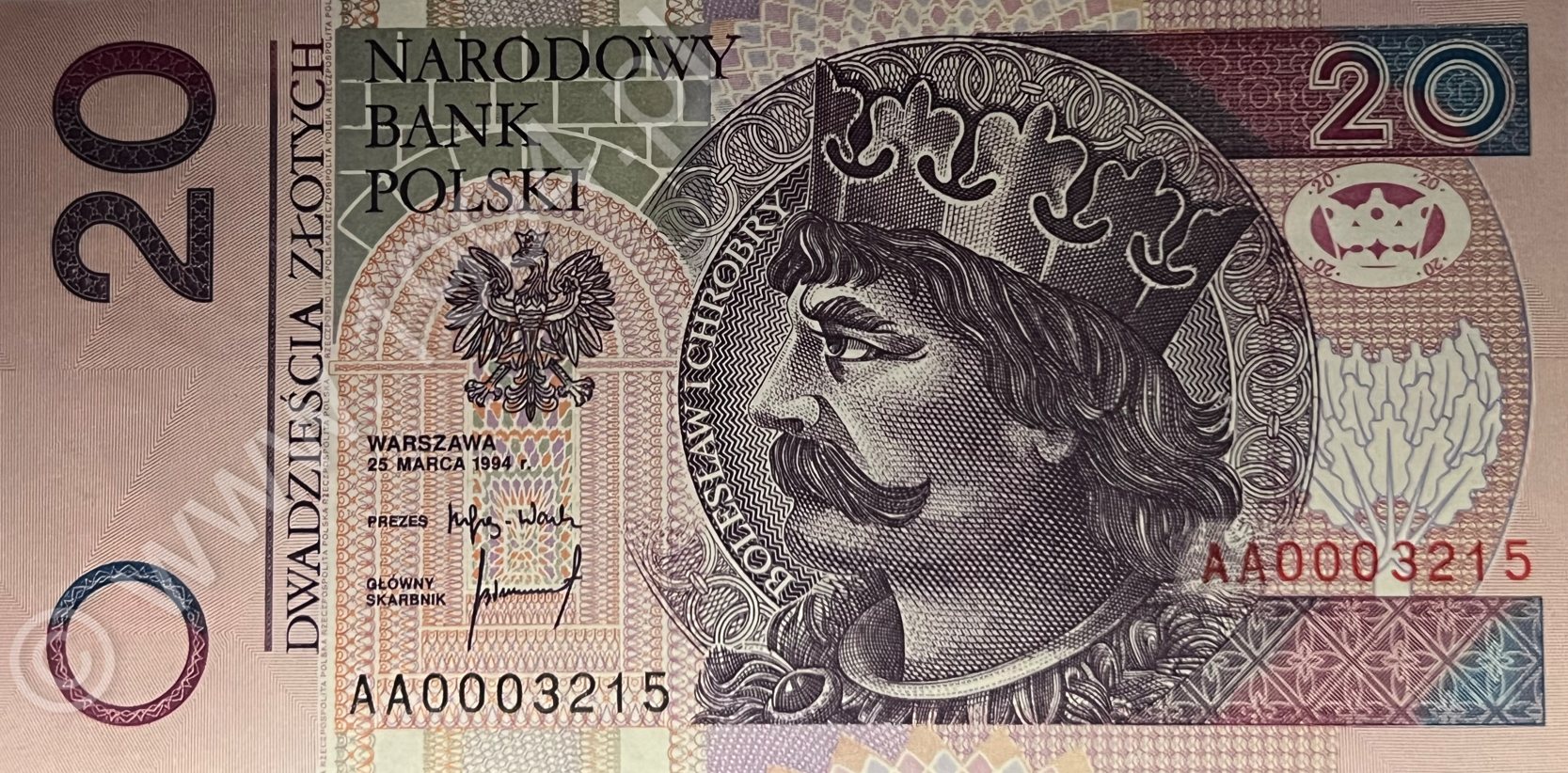
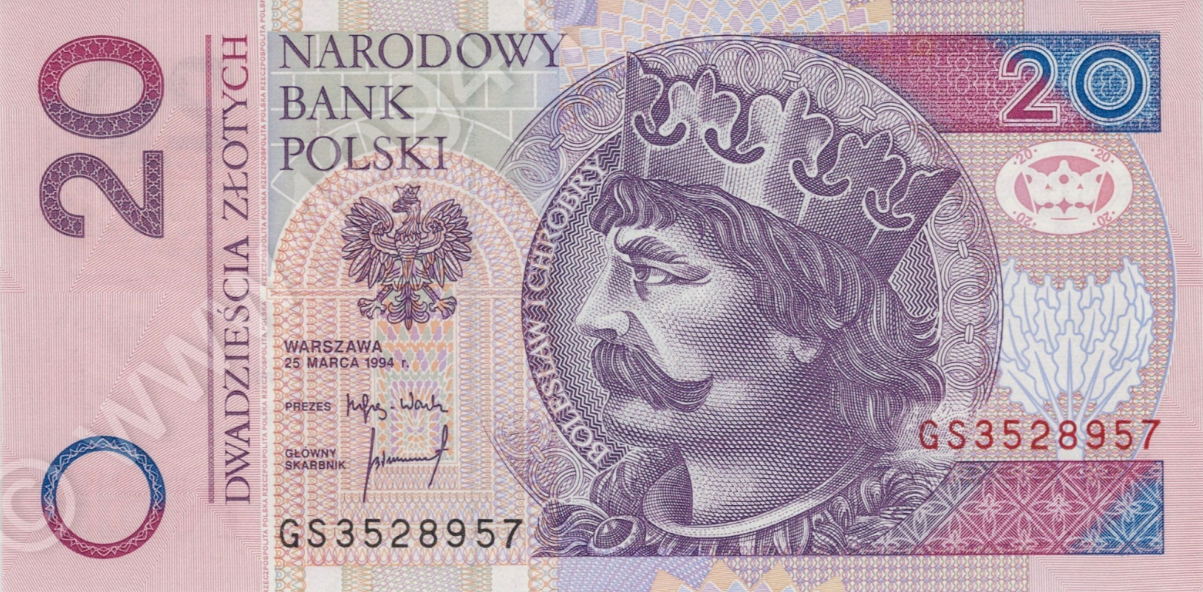
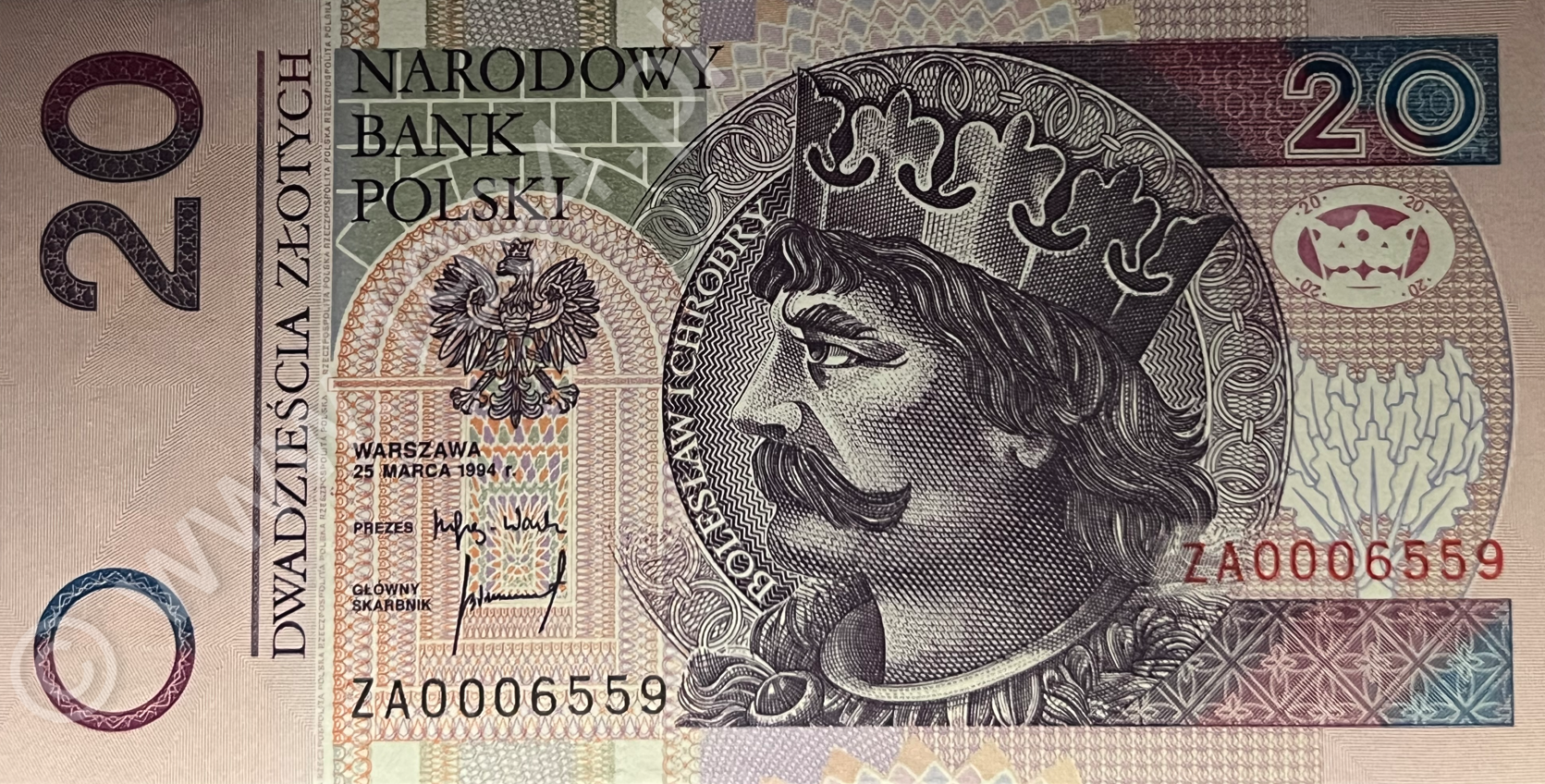
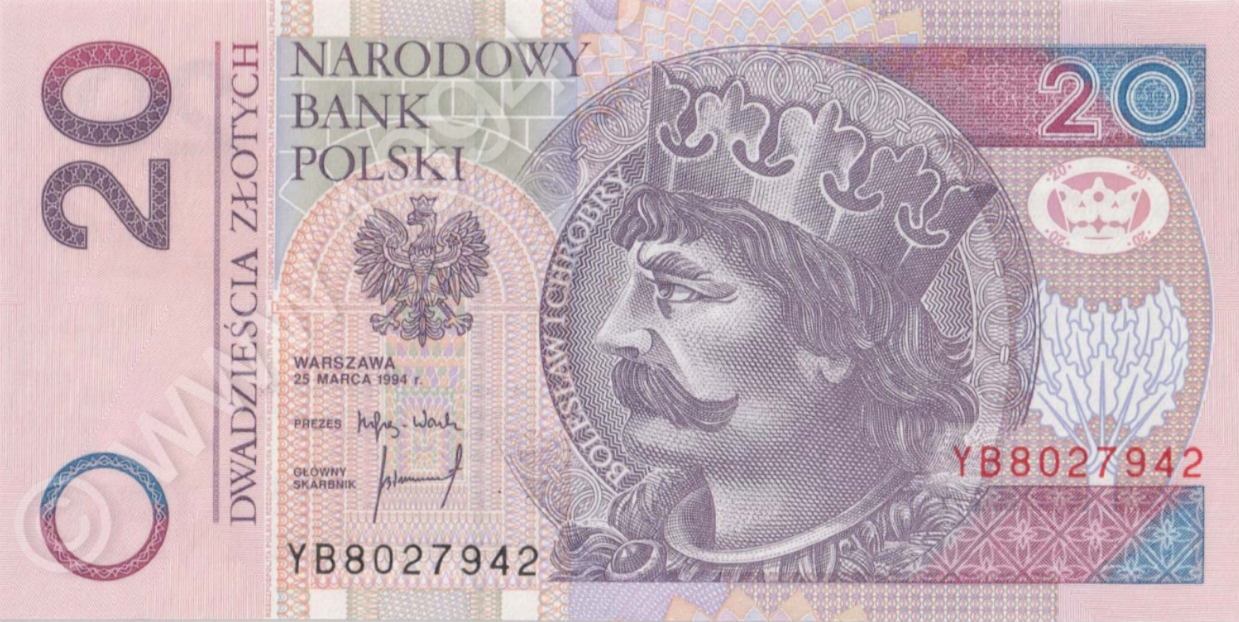
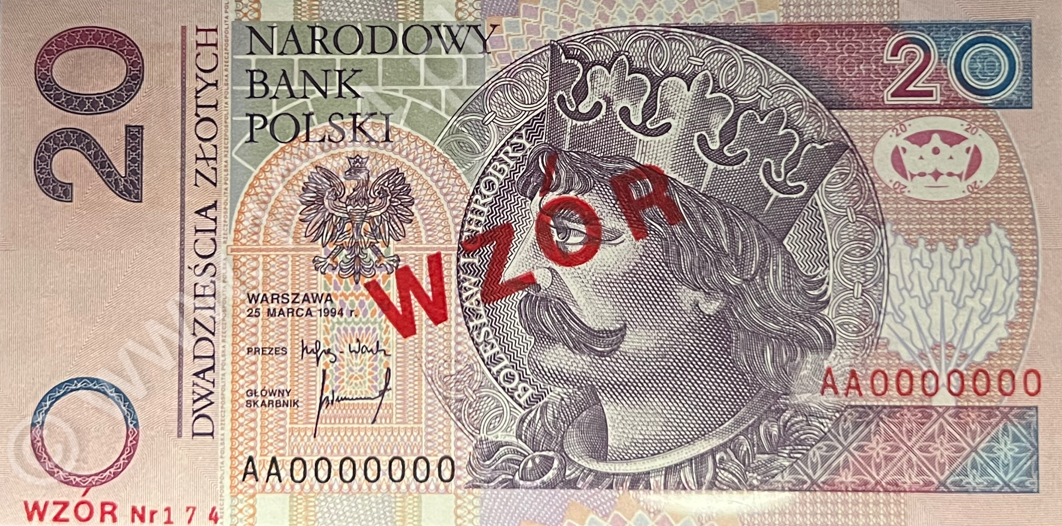
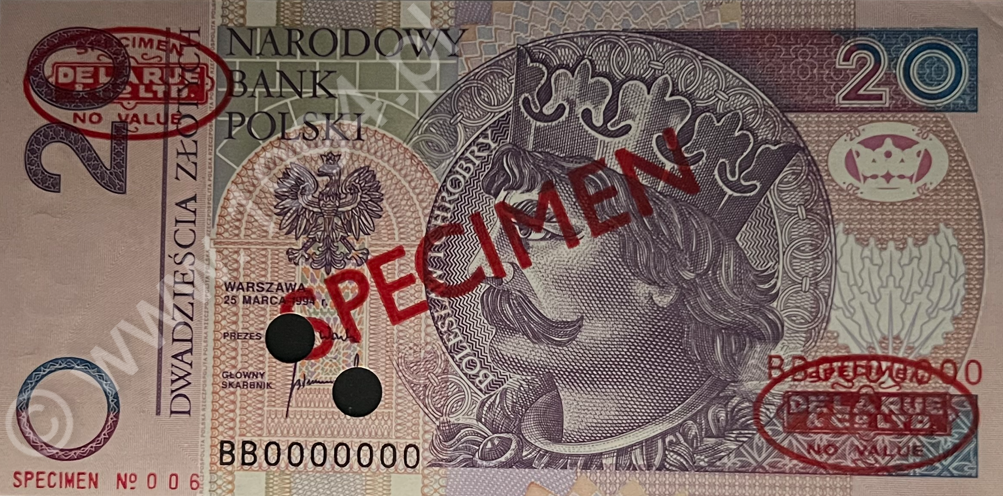

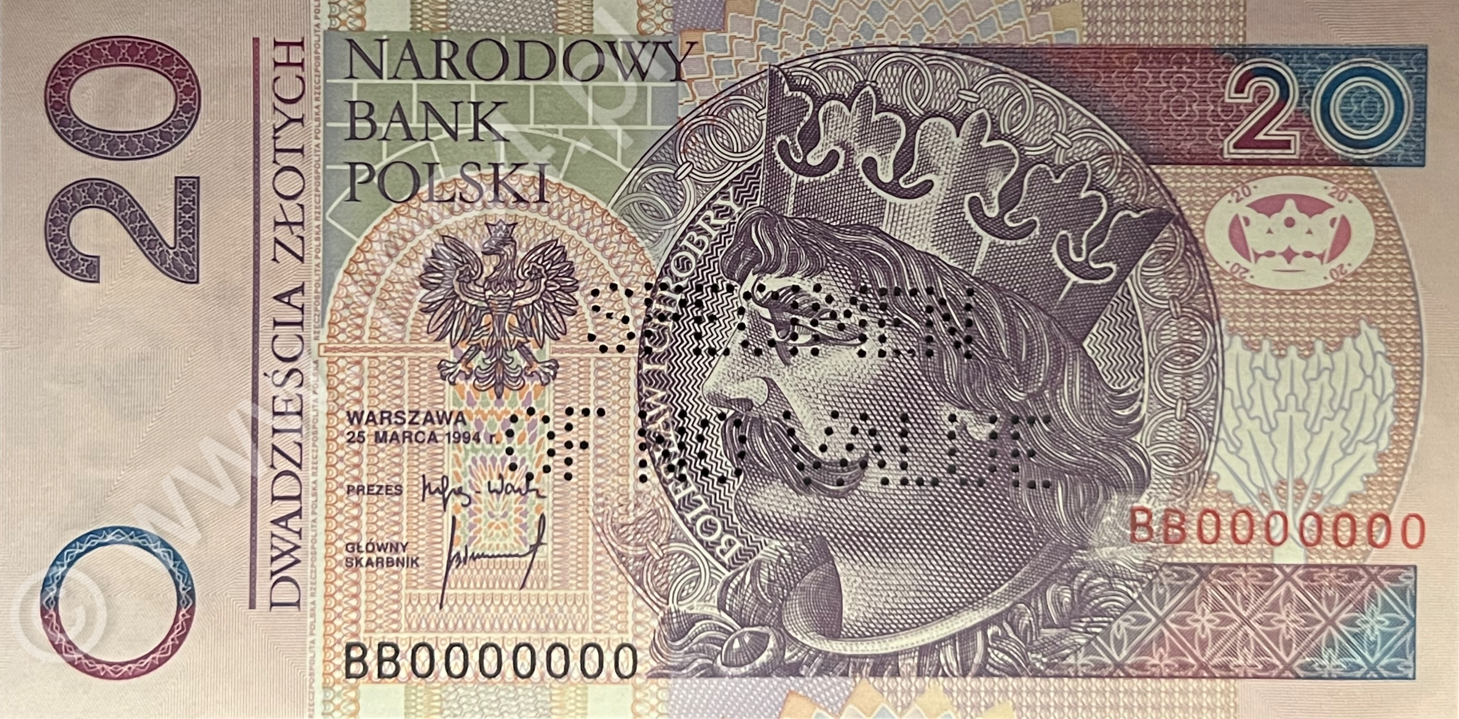
Contact
Questions, contributions, or additional images and variants to add? Write to: info@1994.pl
Bibliography & sources
- Czesław Miłczak, Katalog banknotów polskich
- Standard Catalog of World Paper Money (Pick)
- NBP articles and materials
- Archival auctions: OneBid, Heritage, and others
- PMG publications ( Paper Money Guaranty )
This section is being expanded on an ongoing basis. Links to external sources will be added later.